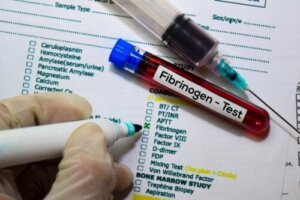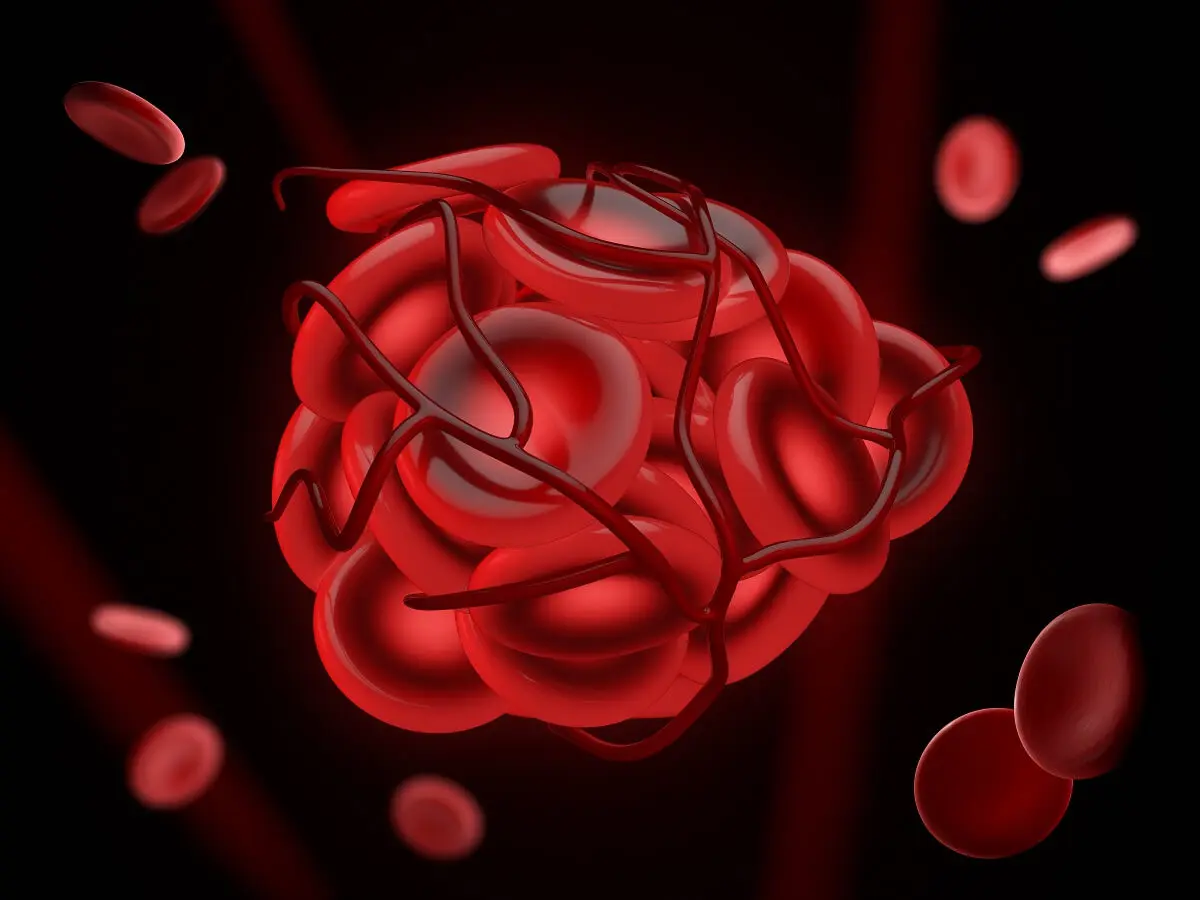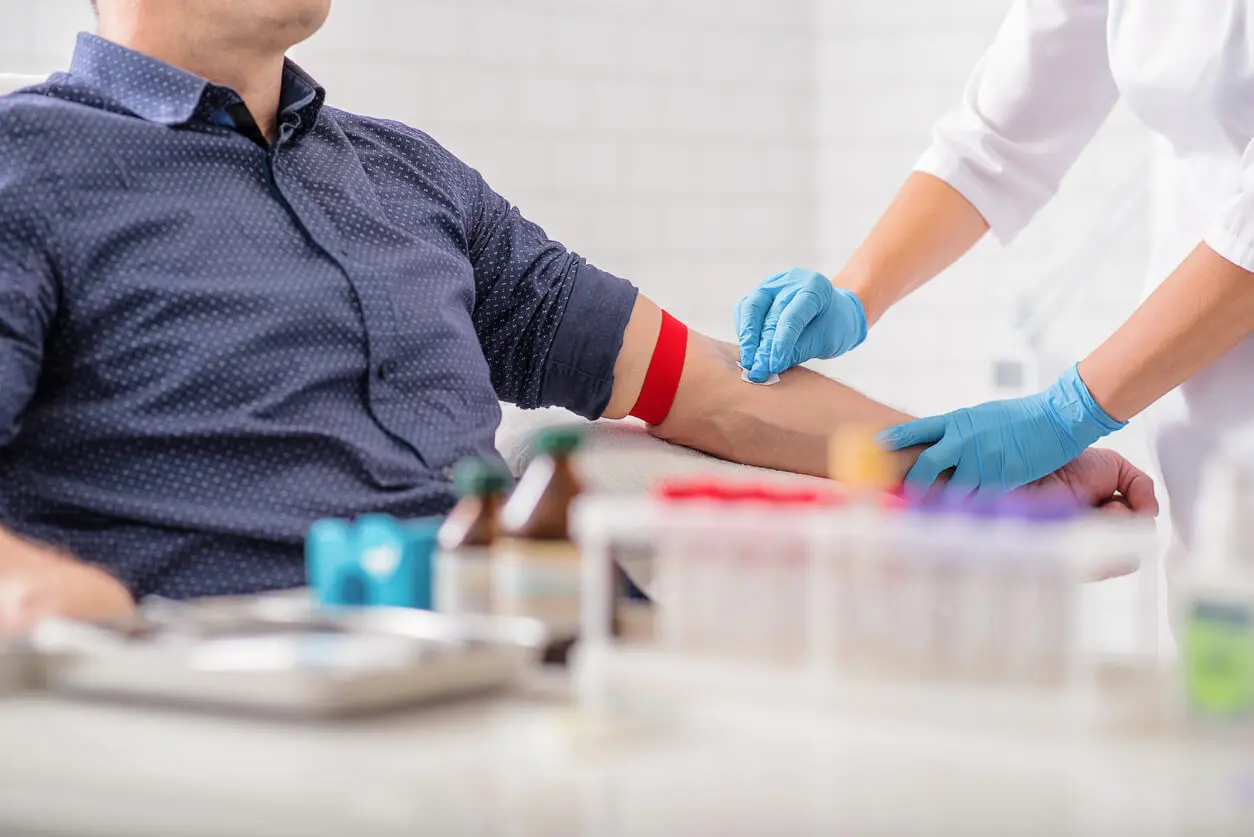Fibrinogen Blood Test: Functions and Results


Reviewed and approved by the nurse Leidy Mora Molina
The fibrinogen blood test is used to determine the levels of this substance that is related to clotting.
The normal level should be between 200 and 400 milligrams per deciliter (mg/dl) of blood. However, this varies somewhat with the person’s age. In fact, in children under the age of five, it’s usually a little lower.
However, the test results can show whether there’s a deficiency or, conversely, high levels of fibrinogen in the blood. In turn, this increase or decrease is related to various factors, such as disease, pregnancy, menopause, drug use, among others.
What is fibrinogen and what is its function?
There has always been great interest in understanding coagulation. In ancient times it was thought that this process was due to solidification by cooling. It was at the beginning of the 20th century, with the publication of a study by Paul Morawitz, that research on the subject was refocused.
Fibrinogen or Factor I is a protein synthesized in the liver that is incorporated into the blood plasma. It is part of the group of coagulation factors, along with prothrombin, calcium, and tissue factor, among others. There are 13 in total.
It is one of the elements responsible for stopping bleeding when there’s a wound or hemorrhage. This complex process is known as “hemostasis” or the “coagulation cascade”.
During this process, thrombin helps convert fibrinogen into fibrin, which functions as a cement and forms a mesh or network. In turn, platelets stick together – like bricks – to produce a clot that plugs the wound.
In the opposite process, which is fibrinolysis, fibrin activates an enzyme that degrades clots (called plasmin) and fibrinogen inhibits it. This ensures that everything happens in an ideal way; clots are broken down when they’re no longer required and aren’t formed unnecessarily.
As some people know, clots can be harmful; if they block blood vessels, they could cause a heart attack or stroke. Therefore, the balance between blood fibrinogen and fibrin is paramount.
In addition, fibrinogen is thought to bind and activate white blood cells, thus playing an important role in the immune response to infection or injury.
Some recent findings seem to confirm this. For example, in an investigation of patients with sepsis, rapid recovery, and lower mortality were correlated with increased fibrinogen.
Another laboratory study in mice with acetaminophen-induced liver damage found that fibrinogen can help repair the liver by activating white blood cells.

Read more: Coagulation Problems: How does Coagulation Work?
All about the fibrinogen blood test
The fibrinogen blood test is performed to estimate how the clotting process is working. It’s often suggested to be performed after fasting for up to 12 hours. Even if no special preparations are required, the physician may recommend stopping any medications beforehand, especially anticoagulants.
To perform the test, a serum sample is drawn directly from the vein (either cubital or cephalic) with a syringe. The needle is withdrawn when sufficient blood has been withdrawn (approximately 2 cubic centimeters).
A standard amount of thrombin is then added to the sample and the time it takes for the fibrin clot to form is measured. This allows the amount, but not the activity, of fibrinogen in the blood to be determined.
This time is directly proportional to the amount of active fibrinogen in the sample. Therefore, prolonged clot formation times may be due to decreased fibrinogen concentrations or fibrinogen dysfunction.
Risks of the test
Obtaining a blood sample may be more difficult in some people than in others. However, the fibrinogen blood test is a simple, quick, and safe process; there are no major risks or side effects. You may experience only mild pain with the prick and bruising after the prick. These symptoms disappear after a short time (one or two days).
When to do a fibrinogen blood test?
The physician may ask for a fibrinogen blood test, alone or as part of a series of tests, when there are abnormal bleeding or clotting situations. Among other circumstances, the option is considered in any of the following:
- Frequent nosebleeds
- Abundant menstrual bleeding
- Presence of blood in the urine or stool
- Abnormal bleeding from the gums
- Gastrointestinal tract bleeding
- Bruising for no apparent reason
- Rupture of the spleen
- Thrombosis
- Abnormal prothrombin or partial thromboplastin test results
- Symptoms of disseminated intravascular coagulation
- Abnormal fibrinolysis
- Inherited or acquired dysfunction related to coagulation
On the other hand, the fibrinogen blood test allows us to know if the decrease in the activity of this protein is due to an insufficient amount or to a dysfunction; it also serves to monitor the clotting capacity over time.
Along with other tests, it also helps to assess the risk of developing cardiovascular disease, peripheral arterial disease, or myocardial infarction.
Know more: How Often You Should Get Blood Tests?
What do the results mean?
The expected level of fibrinogen in the blood is 200 to 400 milligrams per deciliter (mg/dl), but this may vary somewhat with age. In fact, in children under five years of age it’s lower, 160 to 400 mg/dl. And in newborns or infants under the age of one, it ranges from 80 to 90 to 375 or 385 mg/dl.
When the results aren’t within this range, they’re considered to be higher or lower than expected. Let’s look at each separately.
High levels
In this case, you have the following reference scale (in adults):
- 400 – 600 mg/dl (slightly high): may be due to circumstantial factors. A new test should be performed after a few weeks to see if the values return to normal.
- 600 – 700 mg (moderately high): it’s advisable to consult a doctor. If blood pressure is also high, the risk of stroke is increased.
- More than 700 mg/dl (excessively high): high chance of blood clots forming and damaging the heart or brain.
Low levels
There are three types of blood fibrinogen deficiency:
- Afibrinogenemia or total absence of fibrinogen: rare (affects one person in 2 million). Although it doesn’t necessarily cause bleeding, when there is bleeding it’s severe.
- Hypofibrinogenemia: low fibrinogen levels, below 200 mg/dl. It’s associated with mild bleeding.
- Dysfibrinogenemia: blood levels are normal, but fibrinogen doesn’t function properly. It can be congenital or acquired and affects one person in a million. It causes bleeding and thrombosis.
Why do fibrinogen blood levels change?
The alteration of factor I may be temporary. In this case, the possible related factors include pregnancy (which leads to an increase), menstruation, bleeding, a blood transfusion, or reactions to drugs.
Among the drugs that alter the levels of this protein, we can mention the following:
- Oral contraceptives
- Estrogens
- Steroids
- Antituberculosis drugs
- Anti-androgens
- Aspirin
- Warfarin
- Various cholesterol-lowering drugs
On the other hand, low fibrinogen blood levels can be caused by factors such as menopause or smoking, as well as by other conditions, whether hereditary or acquired. Among the latter are the following:
- Tumors
- Severe malnutrition
- Nephrotic syndrome
- Inflammatory disorders (such as rheumatoid arthritis)
- End-stage liver disease
However, the changed values reflected in the test aren’t usually used to provide relevant diagnostic information about any condition or disease.

Associated disorders
Maintaining altered fibrinogen values should be monitored, as it may increase the risk of developing various diseases. If levels are low and bleeding in wounds doesn’t stop or takes too long, the chances of infection increase.
Conversely, high levels promote blood clotting, even when it isn’t necessary. As a result, cardiovascular problems are more likely, as thrombi form, which can lead to heart attacks or strokes.
Normalization of fibrinogen levels
When the increase in fibrinogen is due to pregnancy or is caused by an inflammatory process, levels will return to normal once the underlying problem is resolved. However, in certain cases treatment is required.
For example, depending on the cause of the problem, bezafibrate or replacement therapy with blood product substitutes may be prescribed.
If there’s a risk of cardiovascular disease, lifestyle changes are recommended, such as a diet rich in omega-3, physical exercise, and giving up smoking and alcohol.
All cited sources were thoroughly reviewed by our team to ensure their quality, reliability, currency, and validity. The bibliography of this article was considered reliable and of academic or scientific accuracy.
- Acharya SS, Dimichele DM. Rare inherited disorders of fibrinogen. Haemophilia. 2008; 14(6): 1151-1158. doi: 10.1111/j.1365-2516.2008.01831.x.
- Bennett J. Platelet-fibrinogen interactions. Ann N Y Acad Sci. 2001; 936: 340-354.
- Chernecky CC, Berger BJ. Fibrinogen (factor I) – plasma. In: Chernecky CC, Berger BJ, eds. Laboratory Tests and Diagnostic Procedures. 6th ed. St Louis, MO: Elsevier Saunders; 2013.
- Kamal A, Tefferi A, Pruthi R. How to interpret and pursue an abnormal prothrombin time, activated partial thromboplastin time, and bleeding time in adults. Mayo Clin Proc. 2007; 82(7): 864-873.
- Montalescot G, Collet J, Choussat R, Thomas D. Fibrinogen as a risk factor for coronary heart disease. Eur Heart J. 1998; 19 Suppl H: H11-7. PMID: 9717059.
- Monroe D, Hoffman M. The clotting system – a major player in wound healing. Haemophilia. 2012 Jul;18 Suppl 5:11-6.
- Pai M. Laboratory evaluation of hemostatic and thrombotic disorders. In: Hoffman R, Benz EJ, Silberstein LE, et al, eds. Hematology: Basic Principles and Practice. 7th ed. Philadelphia, PA: Elsevier; 2018:chap 129.
- Tennent G, Brennan S, Stangou A, et al. Human plasma fibrinogen is synthesized in the liver. Blood. 2007; 109 (5): 1971-1974.
- Verhovsek M, Moffat K, Hayward C. Laboratory testing for fibrinogen abnormalities. Am J Hematol. 2008;8 3(12): 928-931.
- Weisel J. Fibrinogen and fibrin. Adv Protein Chem. 2005; 70: 247-99. doi: 10.1016/S0065-3233(05)70008-5.
This text is provided for informational purposes only and does not replace consultation with a professional. If in doubt, consult your specialist.








